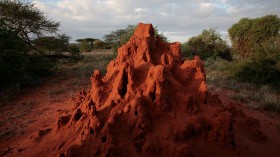According to NASA, if the right type of airborne radar data is collected regularly, scientists may be able to predict sinkholes before they occur.
The revelation comes after NASA scientists analyzed radar data from Louisiana in 2012 that detected indications of a huge sink hole before it broke open in Bayou Corne, about 75 miles west of New Orleans.
NASA has an ongoing campaign dedicated to monitoring sinking ground along the Louisiana coast. Through collecting this airborne data form what's called interferometric synthetic aperture radar (InSAR) via unmanned aerial vehicles, NASA researchers were able to measure the subtle deformations in the Earth's surface that led to the Bayou Corne sinkhole forming.
The analyses show that the ground surface layer deformed significantly across a horizontal plane at least a month before the sinkhole collapsed.
"While horizontal surface deformations had not previously been considered a signature of sinkholes, the new study shows they can precede sinkhole formation well in advance," said Cathleen Jones, a researcher at NASA's Jet Propulsion Laboratory (JPL) in Pasadena, Calif. "This kind of movement may be more common than previously thought, particularly in areas with loose soil near the surface."
The Bayou Corne sinkhole ruptured on Aug. 2, 2012. The collapse of an underground salt dome cavern connected to a wall of an underground storage facility caused the sinkhole to open. The storage facility was connected to a nearby well operated by Texas Brine Company. The storage facility had been mined closer to the salt dome than originally believed.
After rupturing, the sinkhole became flooded with a mixture of water and pulverized solids called slurry. Today it measures 25 acres across, at least 750 feet deep, and it is still expanding.
"Our work shows radar remote sensing could offer a monitoring technique for identifying at least some sinkholes before their surface collapse, and could be of particular use to the petroleum industry for monitoring operations in salt domes," said JPL researcher Ron Blom. "Salt domes are dome-shaped structures in sedimentary rocks that form where large masses of salt are forced upward. By measuring strain on Earth's surface, this capability can reduce risks and provide quantitative information that can be used to predict a sinkhole's size and growth rate."
The sinkhole may eventually encroach upon Highway 70 and area neighborhoods, so there is pressure to get reliable estimates of how fast it may expand and to what extent it may grow.
"This kind of data could be of great value in determining the direction in which the sinkhole is likely to expand," Jones said in a statement. "At Bayou Corne, it appears that material is continuing to flow into the huge cavern that is undergoing collapse."
However, Blom said NASA has no immediate plans to collect aerial radar data over sinkhole-prone areas.
"You could spend a lot of time flying and processing data without capturing a sinkhole," he said. "Our discovery at Bayou Corne was really serendipitous. But it does demonstrate one of the expected benefits of an InSAR satellite that would image wide areas frequently."
© 2024 NatureWorldNews.com All rights reserved. Do not reproduce without permission.





